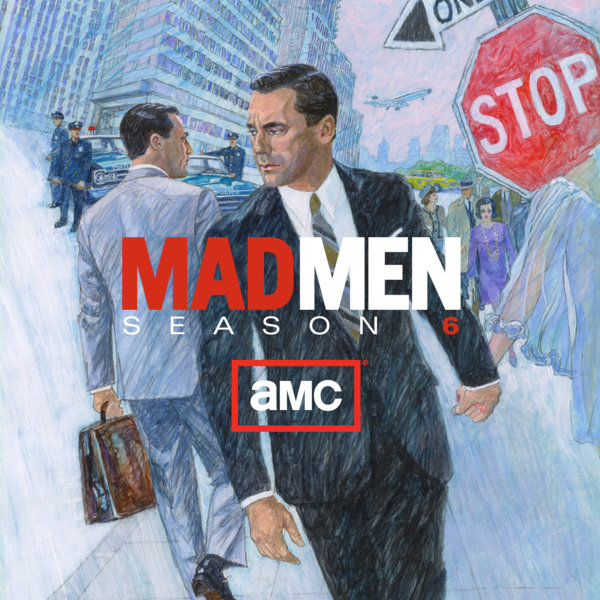
As my husband and I watched our way through Mad Men, I took notes about things that are in the show that are different from today. This post is about Mad Men Season Six. We watched the entire series on Netflix.
Before you read this, you might want to read what I wrote about previous Seasons:
Mad Men Season One
Mad Men Season Two
Mad Men Season Three
Mad Men Season Four
Mad Men Season Five
Warning: There are spoilers.
Episode 1:
* Megan uses a Kodak Instamatic camera to take a photo of Don while they are on a work/vacation in Hawaii. The Kodak Instamatic was launched in 1963. It used a 126 film cartridge.
The Kodak Instamatic 104 was released in 1968. It had a holder for a single flashbulb on the top of the camera. Take a photo with the flashcube, and cock the camera for the next exposure (meaning – roll the film for the next photo). The flashcube would turn 90 degrees to bring the next flashbulb into position automatically.
* The maid was vacuuming while Don was watching TV. The television had two squiggly lines of interference across it – one near the top of the screen and one near the bottom.
It was not a common problem, and the TV went back to normal when after the vacuum was shut off.
Episode 2:
I did not see anything in this episode that was different from today (and that wasn’t already mentioned in this list or the lists about previous seasons.)
Episode 3:
* The news in the background on televisions in various scenes discuss the Vietnam War. It has been said that Vietnam was the first “television war”, or the first “living-room war” (the room people watched television in.)
Being able to sit in your home, in front of your TV, and watch what was happening in a war far away had an effect on people. At first, TV stations were trying to be upbeat – providing wire reports or a battlefield roundup. Later, things got darker and some “horror of war” was televised. The ability to watch the war on TV had an effect on people’s opinion about the war.
In 1968, the Tet Offensive happened. It appears that this is what the television news is talking about in this episode of Mad Men.
Episode 4:
* Joan and her friend Kate go to a restaurant where there is a telephone at every table. The name of the restaurant is “Ma Bells”. The name is a play on The Bell Telephone Company. Ma Bells was the creation of Restaurant Associates. The restaurant actually existed.
Every table had a telephone on it. People called their order into the kitchen. The telephones could also be used to call someone who was sitting at another table.
* Megan and Don go out to dinner with Megan’s coworker and boss (who are a married couple.). During the dinner, it is revealed that the couple are “Swingers” who are interested in swinging with Megan and Don.
Swingers were people who had open relationships. Some were heterosexual, and some were bisexual. Being a swinger became popular in the late 1960s, when the “free love” movement was taking place and casual sex was becoming an accepted thing among some people. Swingers felt it was natural to have sexual desires outside of your relationship, and to act on those desires (if the desired person was consenting.)
Episode 5:
* This episode focused on when Martin Luther King Jr. was shot and killed.
* Someone (I forgot who) turns on a black and white television. A bright dot appears in the center of the screen, which becomes a horizontal line, that eventually spread out over the screen. This was how televisions at the time warmed up if they had not been turned on in a while.
* Don takes Bobby to watch a movie. They see “The Planet of the Apes.” At the end of the movie, it’s clear that Bobby liked it. Don asked “Do you want to see it again?” Bobby does, so they stay in their seats and watch the movie again. This wasn’t unusual and was allowed at the time.
Episode 6:
* I didn’t see anything in this episode that hasn’t already been mentioned in this list (or the lists I put together about previous episode)
Episode 7:
* Pete’s mother comes to his apartment. The handyman calls Pete to let him know she is there. Pete tells the handyman to fix his mother a drink. The ice cube tray is made out of aluminum. It has a quick release handle on it that you pull up to crack the ice cubes. Today, ice cube trays are plastic and you twist them to crack the ice.
Episode 8:
* The office is visited by a “doctor” (brought in by one of the partners of the company that Don’s company merged with). The man is not really a doctor. He was brought to “fix everyone up.” Don agrees to see the “doctor” because he is suffering from a bad cough.
The “doctor” injects several of the men in the office with an unknown concoction. Based on the actions of the men who took this injection – it appears that at least some of it is amphetamine.
The “doctor” appears to be somewhat based on a real person named Max Jacobson who was known as “Dr. Feelgood”. Jacobson did have a background as a doctor – but was known for mixing up unknown ingredients (along with amphetamine) and injecting that into the (often famous) people who came to him for help. Jacobson “treated” JFK, Marylin Monroe, Eddie Fisher, and others.
Episode 9:
* Don stops at a gas station and tries to get the gas station attendant’s attention. It was a full service gas station (which was standard at the time). People did not pump their own gas – the attendant did it for them.
The gas station attendant would fill the tank, check the tire pressure, check the oil, and wash the cars windows. People paid for the gas, but the other services were provided for free. Gas stations used to hand out trinkets as well – for travelers to collect. (drinking glasses, key chains, calendars, road maps, etc).
There are some places in the United States today where people are required by law to allow a gas station attendant to pump their gas for them. It is no longer a common practice – and does not come with the extra services.
Episode 10:
* Joan tells a potential client that Harry works on figuring out where to place television ads “with a computer as big as this room”. The first personal computer wasn’t introduced until 1975 – and they were kits that people had to put together themselves.
* This episode focused on the 1968 Democratic National Convention that took place in Chicago.
* Megan watches the violence that took place outside the DNC. She calls Don, who is watching it, too, (while away on business). Megan says she can’t vote – but still cares about what’s going on. Megan is Canadian. She was from Quebec.
* There is a lava lamp on the desk in the Creatives Office. The lava lamp was created by Edward Craven Walker (who was a British accountant). He sold the U.S. manufacturing rights in 1965 to a company named Lava Lite. In 1968, lava lamps were marketed to executives.
Episode 11:
* The office, which is in New York, receives fresh oranges from California from Sunkist (who is a client). In a previous episode, Roger’s daughter told him that her husband had this great idea about investing in refrigerated trucks that ship produce. This indicates that it was not easy to obtain fresh oranges from California if you lived in New York. Those oranges were a big deal.
* Sylvia and Arnold (Don’s neighbors) have a son, Mitchell, who is 18. He returned his draft card as a form of protest of the Vietnam War. After Mitchell dropped out of school, the military re-classified him 1-A. This designation meant that it was extremely likely that Mitchell would be drafted and sent to Vietnam.
Mitchell tells his problem to Megan (who relays the problem to Don). Megan said that Mitchell was “going to run”. This meant that Mitchell was going to leave the United States and go to Canada in order to avoid being drafted. Megan considers helping Mitchell because she has family in Canada.
Much of this episode is about how to solve Mitchell’s problem.
Episode 12:
* I didn’t notice anything new in this episode (that wasn’t already mentioned in this post or in posts from previous seasons.)
Episode 13:
* Sally get suspended from boarding school because she used a fake ID with her mother’s name on it and bought alcohol for herself and the other girls. Betty calls Don, all upset. Betty tells Don that the reason why “nothing is working” and “the bad is beating the good” is because Sally is “from a broken home.” That’s not a phrase people use today in regards to a child from a family where the parents got divorced and remarried.
Things from Mad Men that are Different from Today – Season Six is a post written by Jen Thorpe on Book of Jen and is not allowed to be copied to other sites.
If you enjoyed this blog post please consider supporting me on Ko-fi. Thank you!

One comment